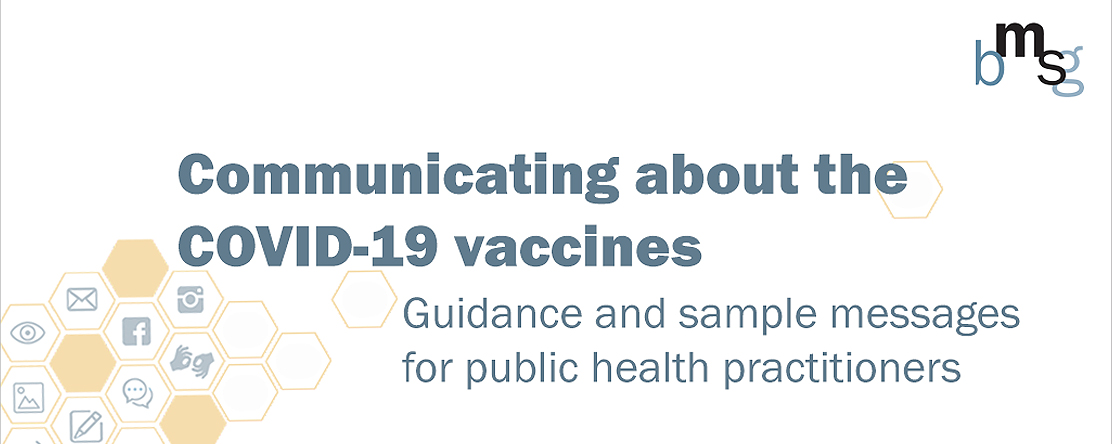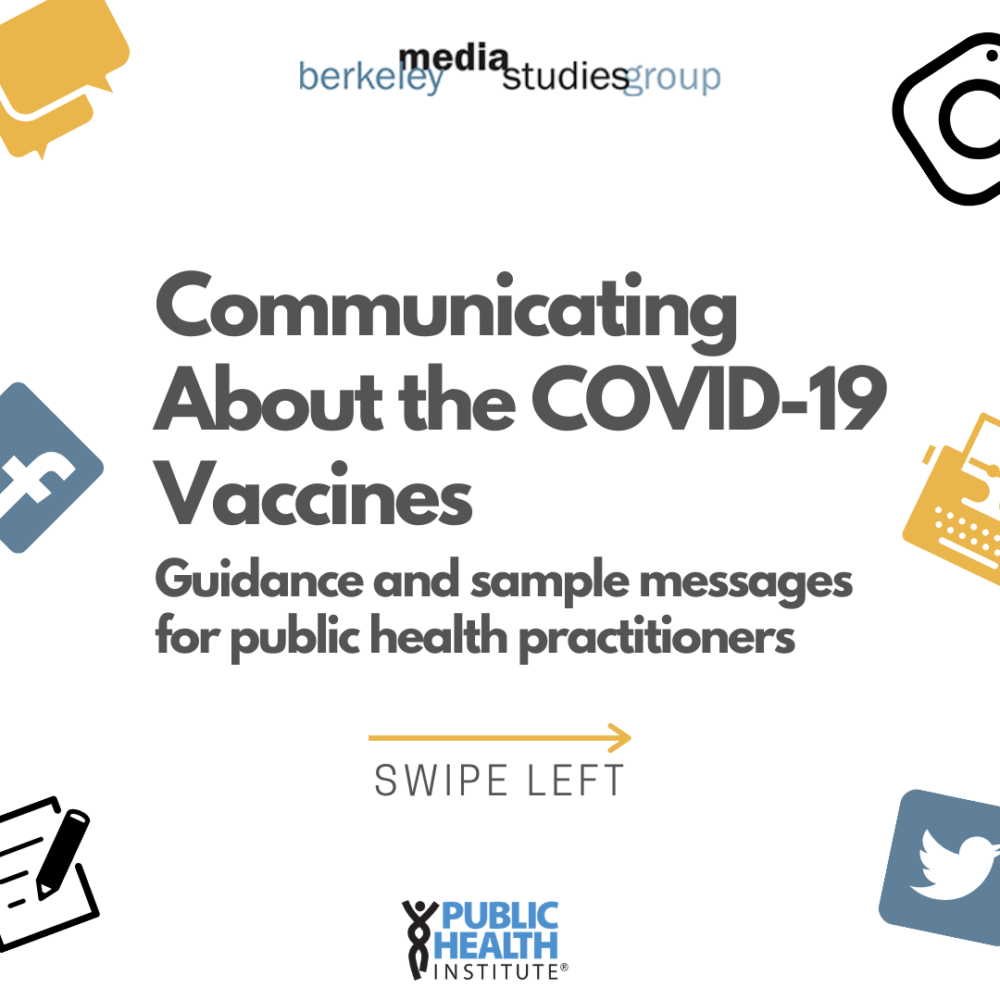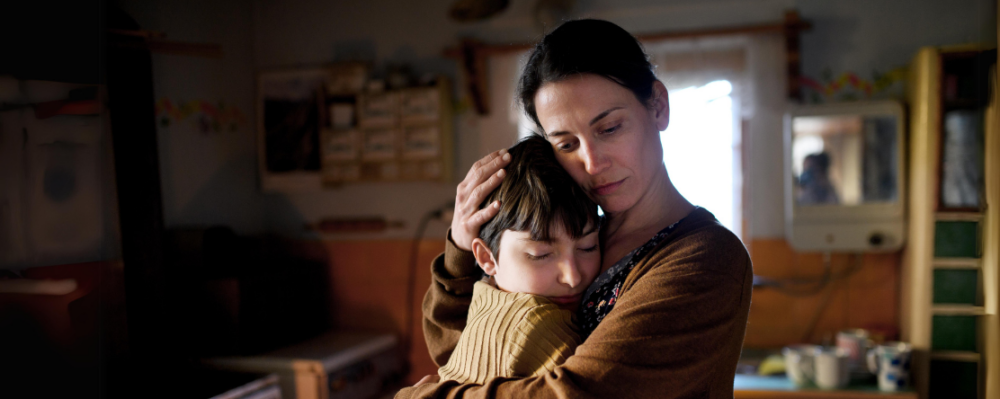
Communicating about the COVID-19 Vaccines: Guidance and Sample Messages for Public Health Practitioners
-
Focus Areas
Capacity Building & Leadership -
Programs
Berkeley Media Studies Group -
Strategic Initiatives
COVID-19, Vaccine Access & Equity

Communicating about the COVID-19 vaccines: Guidance and sample messages for public health practitioners
The first COVID-19 vaccines will soon be available in the United States. The science is clear: Vaccines save lives. But despite overwhelming evidence of their effectiveness, vaccines remain a contentious issue, with municipalities across the country often receiving vocal pushback in response to their efforts to implement immunization programs. With the onset of the global COVID-19 pandemic, and the race to develop vaccines, the debate has taken on a new importance.
This resource, from PHI’s Berkeley Media Studies Group, contains tips to help public health leaders communicate more clearly and effectively about vaccines. Residents will have many questions about the rollout of the vaccine, and policymakers, the media, and the public are turning to public health practitioners for accurate, timely information. Public health practitioners can communicate effectively even in this chaotic time. Other public health issues — like practicing safer sex — have shown us that widespread shifts in individuals’ behavior to support health actions is possible, even though it can be challenging.
There is no one easy communication solution, but here BMSG provides some quick tips for:
- communicating effectively about the COVID-19 vaccines, or vaccines in general, and
- bringing equity forward in your communication.
At the end of this resource, there are general tips for good communication.
When you communicate about the COVID-19 vaccines, or vaccines in general, remember …
Meet people where they are.
Most people’s willingness to vaccinate falls on a continuum from acceptance, to questioning, to doubt, to outright rejection. Diverse groups across that continuum — even people who intend to get the vaccine — will have questions about vaccine safety that need to be answered, especially regarding the COVID-19 vaccine. Vaccine opponents are very visible and vocal in political debates on vaccines in general and the COVID-19 vaccine in particular, which can increase doubt.
Some who are considering, but have questions about, the vaccine may fear or resent being cast as “anti-vax” or having their concerns dismissed as ridiculous. Recognize where your audience may be on the spectrum of vaccine support and avoid stereotyping people who ask questions or express reluctance as “anti-vax.” Instead, use language like “vaccine hesitant” or “vaccine questioning,” acknowledge that people are seeking to stay healthy and safe, and assure them that having questions is an important part of the process.
Since your audience will be confronted with a barrage of information about the COVID-19 pandemic, make sure to acknowledge that, beyond questions, your audience may have legitimate, deep-seated fears about the vaccine and the pandemic itself. Research has shown that acknowledging an audience’s fears and doubts about difficult subjects can help assuage those fears, build trust in messengers, and circumvent shame and frustration. When you acknowledge your audience’s stance about vaccinations — and the complex emotions they may be feeling — it helps them remain open to what you have to say.
Putting it into practice: Meeting people where they are
Sample message that helps people understand the research process: We understand that some people may be nervous about the COVID-19 vaccines — this is totally reasonable. Fortunately, researchers have been working on vaccines for the coronavirus family for years, so they did not have to start from scratch. As researchers have been working intensely to develop and test the vaccine, they have been transparent in sharing data, holding live hearings, and pausing trials when it’s been important to slow down. Vaccine makers have also pledged that they would not seek FDA approval until phase 3 testing is done. All of this has given us trust and confidence in vaccination — a critical tool in our toolbox in slowing the spread of COVID-19 and helping our communities move forward. *We have sacrificed so much this year to keep our loved ones and community safe. **While we know getting vaccinated isn’t always comfortable, you can play a big role to support our county by keeping yourself and your family up-to-date on vaccinations — including the seasonal flu shot and the COVID-19 vaccine once it is available. By staying updated on immunizations, we can make sure our sacrifice and efforts to fight COVID-19 keep everyone safe.
*Conveys health department identity and values
**Acknowledges that vaccination can be uncomfortable and notes sacrifice of community
(Adapted from Dr. Theresa Chapple’s Twitter thread)
Clearly explain the COVID-19 immunization process.
Between the news and social media, there are multiple sources demanding your audience’s attention with conflicting and confusing messages. Public health practitioners are an especially important source for providing credible and consistent information to the public because they can explain what will happen locally. Materials should make it easy for residents to understand the process of the vaccine rollout and specific technical questions. Prepare materials that use clear, plain language to answer questions like:
- Where and when can people get the vaccine?
- What will people feel like after they receive the vaccine? Are there side effects? What does it mean if I don’t feel good after I get the shots?
- Why do people need to receive two vaccinations from the same manufacturer? How can people know which one they are receiving?
- Are there costs associated with the vaccine? If so, will my insurance pay?
- Who determines which groups get the vaccine first? Why are some groups prioritized?
- Do we still need to wear masks and keep social distancing while we roll out vaccinations?
- Where can people get more information?
To bring racial equity forward in communicating about COVID-19 vaccines …
Prepare for discomfort and distrust.
Multiple articles and advocates have noted that there are good reasons for people, especially Black, Indigenous, Latinx, Asian, Pacific Islander, and other people of color, to distrust the medical and public health fields. This distrust extends to recommendations about the COVID-19 vaccine.
There are no magic words that can build trust and erase centuries of medical and public health neglect and abuse. Much racial equity work extends beyond communication to transforming organizations, engaging with communities who have been most harmed to help support their power-building efforts, and doing the long-term work it takes to earn the trust of communities that have been harmed by medicine and public health. By building relationships that encompass organizing for policy change, providing COVID testing and treatment, listening to the needs of communities, and addressing the structural factors that create greater exposure to and poorer treatment for COVID, public health practitioners can build a strong communication infrastructure that helps earn community trust.
Build relationships with trusted messengers from diverse organizations and community groups.
While using clear messaging to align the voices of elected officials, health officers, public health advocates, and medical professionals is essential, these messengers may not be the most trusted entities within parts of our communities. Health departments should engage with and center the voices and perspectives of trusted messengers who have roots in the community; they should also embrace and acknowledge those who may be justifiably distrustful of government and medicine. Trusted messengers could include Black, Indigenous, Latinx, Asian Pacific Islander communities, and other health care practitioners of color, as well as people from community organizations, faith communities, youth organizations, parent and caregiver groups, or unions. Developing long-term relationships with these and other trusted community members takes time — but it is essential. Local health departments can listen to these groups’ concerns and provide support and resources to ensure they have timely, accurate, and concise information to tailor to their communities.
Name racial equity explicitly.
While public health practitioners engage in the long-term work of trust-building to support equity, in the short-term they also need to address racial equity proactively when they communicate about COVID-19. BMSG’s research shows that vaccine opponents regularly invoke historical instances of racially motivated medical oppression to undermine trust in the medical system and government overall. If vaccine supporters stay silent on racial equity, they are conceding the issue to vaccine opponents. A health department could, for example, engage strong supporters and allies — and elevate racial equity — by saying how racism has been used as a tool used to divide us and showing how the department is working to create a healthy community for all residents.
Putting it into practice: Sample language for centering racial equity
Our health department believes that everyone in our county should have the opportunity to be as safe and healthy as possible. This means we must pay particular attention to the communities who are most at risk for COVID-19 and have less access to the supports they need to stay healthy. We know that Black, Indigenous, Latinx, Asian and Pacific Islander communities, and other communities of color are most at risk for exposure to COVID — and suffer poorer health outcomes if they get it — because they are often locked out of affordable homes, safe transportation, quality health care, and jobs that offer paid sick leave and options to work from home. Many of our essential workers who keep our country running — our bus drivers, our farmworkers, our grocery store workers — are from these same communities. This is why they will be among the first to have the option to be vaccinated. And it is why the national recommendations are prioritizing essential workers, in addition to health care workers. The COVID-19 vaccines offer an important opportunity to support and protect those who have been and stand to be most harmed by COVID-19. We know this is only part of the solution, and we must also commit to addressing the social factors that affect our health and that will reduce inequities in health outcomes, like universal basic income, equitable school funding, eviction moratoriums and rent cancellation, and releasing people who are in prison.
Show how the COVID-19 vaccine fits into a larger public health strategy.
Dr. Camara Jones notes that it is important to avoid framing the “vaccine as the cure”: If we talk about vaccines in isolation, we risk reinforcing deeply held beliefs that health (or ill health) is purely a matter of individual behaviors (like choosing to get the vaccine) and obscuring the broader structural factors — like housing, jobs, or health care access — that also impact health and must be taken into account. To integrate equity into our vaccine messages, we need to describe, even briefly, some of the structural factors that affect health in the “landscape” that surrounds us. Evoking the landscape acknowledges the reality that for many communities, a vaccine isn’t going to solve some of the most pressing problems of hunger, job loss, looming rents, crowded prisons, and underfunded schools. Recognizing these realities is one part of building trust and shows that our public health organizations are committed to the full spectrum of needed interventions.
Name what your health department is doing that illustrates public health’s commitment to the hard work it will take to achieve equity, justice, and health for all.
Connect communication about vaccines to these other necessary interventions as a way to build momentum for the systemic changes we need to support racial and health equity. For example, a health department could name immunization as one of a number of strategies to promote community health, in concert with a universal basic income, equitable school funding, eviction and rent moratoriums, and releasing people who are in prison. These strategies might not be the centerpiece of all vaccine messages, especially shorter messages, but they can be part of our communication with the communities we serve.
For good communication, remember …
Always have a clear goal.
Even if the goal seems obvious — like encouraging residents to get vaccinated and ensuring they have all the information they need to do so — be sure all staff developing communication materials understand the goal, audience, key messages, and next steps for each communication opportunity. Review the Layers of Strategy to help set goals and target audiences for short-term and long-term communication. This tool, and the goal you set, will guide the decisions you will make, including what messages to develop.
Keep values front and center.
Messages that lead with values are effective because they move us and motivate us to act. Values like unity, interconnectedness, justice, or pride of place reinforce a vision of what we create together by getting vaccinated: For example, a health department representative could describe how the COVID-19 vaccine keeps the entire community safe, secure, and protected — from teachers to hospital workers and small business owners. You can do this simply by using titles and subtitles that include values (such as “Vaccinating makes everyone safer”). Values are also importing in keeping the focus on equity and equity-focused solutions that emphasize unity, interconnectedness, and inclusion.
Putting it into practice: Sample message from a local health department that leads with values
Our health department’s goal has always been to keep everyone in our county safe and healthy, and that is especially true in this challenging time. We know our residents care about the health of our communities, too. Our hospital beds are filling up, and our doctors, nurses, and health care staff are going above and beyond to take care of our communities. Our small businesses and the people who work there are struggling to stay afloat. One way we can keep each other healthy, support our health care workers, and get California back on its feet is to get vaccinated against COVID-19. When we get vaccinated, we can slow the surge to help our nurses, doctors, schools, fellow community members, and businesses.
Name your solution.
In public health, we often talk more about the problem than the solution — aim to reverse that. The solution could be a policy, like an eviction moratorium or paid sick leave, or an action like people getting vaccinated to prevent community spread of COVID.
Avoid repeating false claims.
Doing so risks inadvertently amplifying and strengthening inaccurate information. Occasionally, public health practitioners may not be able to avoid addressing false claims. In these situations, create messages that sandwich misinformation about vaccinations between the facts about safety and widely shared values about protecting communities. When combined with shared values like trust and protection, this approach, known as a “truth sandwich,” may be an effective tool. Cognitive linguist George Lakoff and journalists are using this technique. Lakoff’s recipe is:
- Start with the truth. The first frame gets the advantage.
- Indicate the lie. Avoid amplifying the specific language if possible, and don’t repeat what’s not true.
- Return to the truth. Always repeat truths more than lies.
Putting it into practice: Sample language for a “truth sandwich”
1. Start with the truth: Our health department’s goal has always been to keep the people in our county safe and healthy, and that is especially true in this challenging time. The COVID-19 vaccines, in addition to ongoing handwashing, distancing, and mask-wearing, offer us a new opportunity to protect ourselves and those around us, from our friends and family to the people ringing up our groceries. We know you want to stay safe and keep your family safe, and part of that involves ensuring you have the information you need about the vaccines to make an informed decision.
2. Indicate, but don’t repeat, the lie: We know many people have questions about the vaccine, and some people who are opposed to it have frightened people with misinformation about the vaccine.
3. Return to the truth: At the same time, there are many people who want to get the vaccine or are considering it because it can mean that we keep our loved ones safe, our schools open, get our local businesses back on their feet, and move our communities forward. As more people are vaccinated, we can protect health care and essential workers, people who are at highest risk, and our broader community. Our focus is on listening to your questions, providing clear, accurate, science-based information, and keeping our community’s health front and center.
For good communication, AVOID traps like …
Trying to say everything.
You can’t be strategic and comprehensive at the same time. Stay focused on the top communication priorities that stem from your goal. This may feel at odds with including details about the broader “landscape” that surrounds us, but if our overarching goal centers equity, we can be strategic about how to talk about the landscape.
Trying to persuade everyone.
Many residents are already eager to get the COVID-19 vaccine. Others aren’t so sure but are open to learning more. And some people will not change their stance, regardless of evidence and strong messages. There’s no one message that will move everyone to be vaccinated, especially those who have politicized the issue. Focus your time and energy on developing messages for those who are willing and need information and for those who are hesitant but open to learning more, rather than trying to persuade those who are completely opposed to vaccination.
Engaging in fruitless arguments.
Responding to social media agitators can be emotionally and cognitively exhausting, and it takes up precious time and resources. Sometimes the best response is no response — often agitators are trying to elicit a reaction and redirect the conversation. Engaging with them pulls more eyes to their accounts and comments. If you decide to respond, create two or three rotating messages that lead with values. Use those messages to respond quickly and move on. Advanced preparation will also reduce the risk of your messaging being reactive. Agitators are not likely to let things go — your goal should be to neutralize their misinformation.
Putting it into practice: Sample language for a social media response to misinformation
Thanks for commenting. To keep everyone in [county name] safe and healthy, we’re using the best science available to address COVID’s threat to our health and economic well-being, including providing the COVID-19 vaccines. We know people have many questions about the vaccine — you can find the most accurate and up-to-date information here: [add website].
Shaming people.
Public health has been successful in shaming industries like Big Tobacco, but shaming individuals rarely works in public health campaigns. And from an equity perspective, people of color have good reason to be cautious about the COVID-19 vaccine. Don’t shame or scold people — instead, meet them where they are by recognizing that these are challenging times, and acknowledge their concerns and questions.
Using jargon.
Plain and simple language can make even complex ideas accessible and comprehensible to a broad range of audiences. Whenever possible, have people outside of your immunization program, and ideally outside of public health, review your materials for words and phrases they do not understand. Create a list of alternatives to jargon that your whole team can add to and use.

See the Sharable Instagram Slides
View our sharable Instagram slides and scroll through for tips from PHI’s Berkeley Media Studies Group for guidance on how to communicate more clearly and effectively about vaccines, build trust by engaging with trusted messengers, and bring forward racial equity.
Originally published by Berkeley Media Studies Group
Work With Us
You change the world. We do the rest. Explore fiscal sponsorship at PHI.
Support Us
Together, we can accelerate our response to public health’s most critical issues.
Find Employment
Begin your career at the Public Health Institute.


